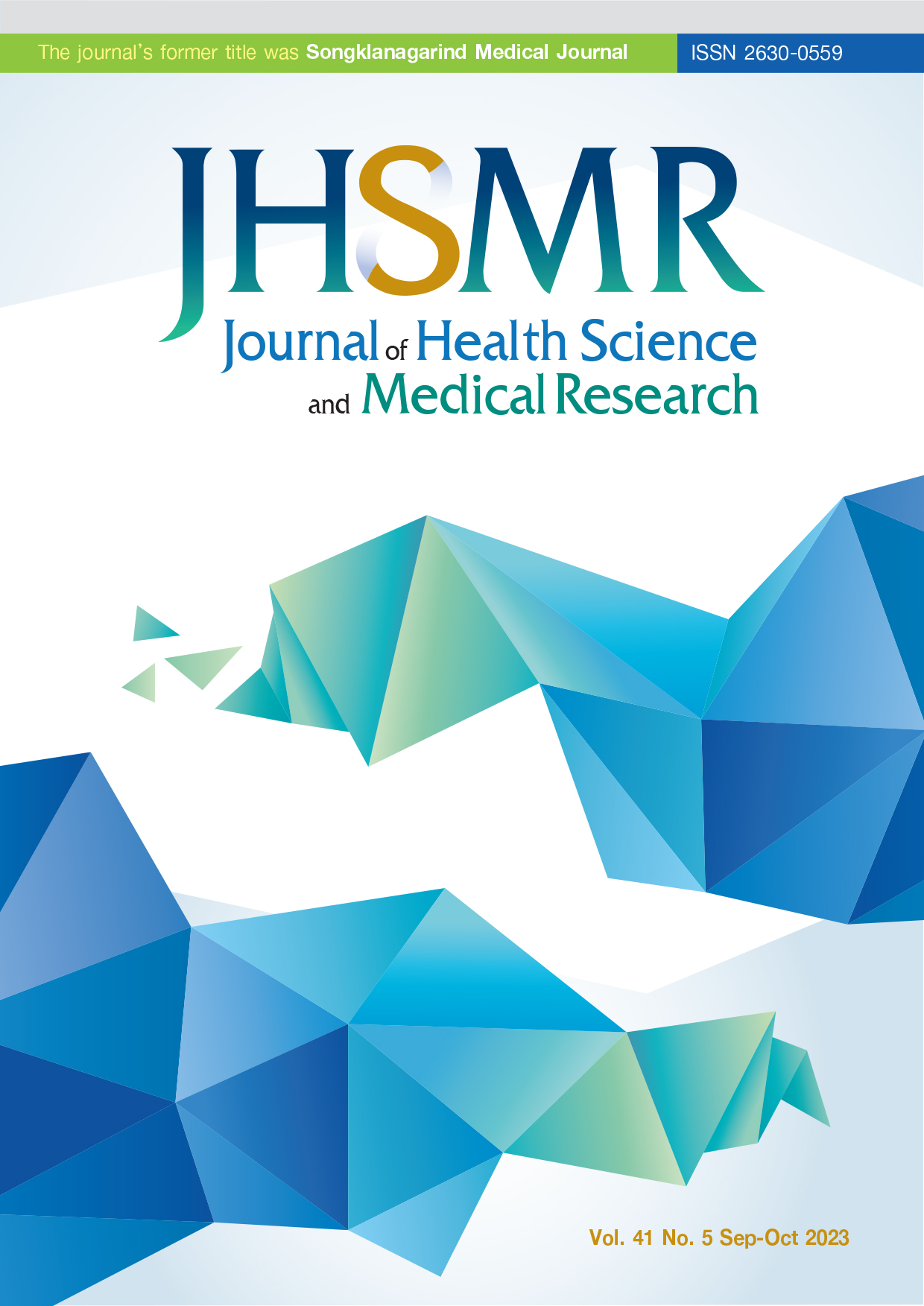Effectiveness of a Case-based Educational Intervention Focusing on Blood and Body Fluid Exposure Prevention among Nursing Students
DOI:
https://doi.org/10.31584/jhsmr.2023953Keywords:
blood and body fluid exposure prevention, case-based educational intervention, nursing students, VietnamAbstract
Objective: There is a relative lack of research regarding case-based educational interventions to improve blood and body fluid exposure prevention practice among nursing students. Hence, this study aimed to investigate the effect of case-based educational intervention on knowledge, attitudes, and behaviors regarding blood and body fluid exposure prevention among nursing students, at some universities in Vietnam.
Material and Methods: This study employed a randomized control trial design. Simple random sampling was used to recruit the target population, to obtain 87 nursing students. Students’ knowledge, attitude and self-reported behavior scale on exposure prevention were used to collect data at three time-points. The 4-week case-based educational intervention was provided to the intervention group (42 students); whereas, the control group received only regular training.
Results: The findings revealed that there were significant, positive differences in students’ knowledge, and attitude toward blood and body fluid exposure prevention in the intervention groups than in the control group after receiving the intervention, which remained over time.
Conclusion: Higher educational institutions should provide case-based educational intervention to nursing students, so as to enhance their blood and body fluid exposure prevention practices.
References
WHO. Health care worker safety: AIDE-MEMOIRE for a strategy to protect health workers from infection with bloodborne viruses. [homepage on the Internet]. Geneva: WHO; 2015 [cited 2021 Oct 12]. Available from: http://www.who.int/injection_safety/toolbox/en/AMHCW_Safety_EN.pdf
Ismail S, Awan S, Naeem R, Siddiqui S, Afzal B, Jamil B, et al. Occupational exposure to HIV in a developing country: assessing knowledge and attitude of healthcare professional before and after an awareness symposium. BMC Res Notes 2018;11:131. doi: 10.1186/s13104-018-3231-y.
Souza-Borges FR, Ribeiro LA, Oliveira LC. Occupational exposures to body fluids and behaviors regarding their prevention and post-exposure among medical and nursing students at a Brazilian public university. Rev Inst Med Trop Sao Paulo 2014; 56:157-63. doi: 10.1590/S0036-46652014000200012.
Dantas F, Fábio F. Risk factors affecting occupational exposure to blood and body fluids among dental students: a cross-sectional study in a brazilian federal university. Clin Biomed Res [serial on the Internet]. 2017 [cited 2020 Dec 7]. Available from: https://seer.ufrgs.br/hcpa/article/view/68843).
Albaqawi HM, Alquwez N, Balay-odao E, Bajet JB, Alabdulaziz H, Alsolami F, et al. Nursing students’ perceptions, knowledge, and preventive behaviors toward COVID-19: a multi-university study. Front Public Health 2020;8:573390. https://doi.org/10.3389/fpubh.2020.573390.
Nalunkuma R, Nkalubo J, Abila DB. Knowledge on infection prevention and control and associated factors among undergraduate health professional students at Makerere University College of Health Sciences, Uganda. PLoS One 2021;16:e0255984. doi: 10.1371/journal.pone.0255984.
Tawiah PA, Oppong K, Effah ES, Abaka-Yawson A, Arhin-Wiredu K. Occupational exposure to blood and body fluids among medical laboratory science students of the university of health and allied sciences during vocational internship in the Volta Region of Ghana. Sci World J 2020 1;2020:4878315. doi: 10.1155/2020/4878315.
Shaghaghian S, Golkari A, Pardis S, Rezayi A. Occupational exposure of shiraz dental students to patients’ blood and body fluid. J Dent (Shiraz) 2015;16:206-13.
Becker MH. The Health Belief Model and personal health behavior. Health Educ Monogr 1974;2:324–508.
Khodaveisi M, Salehi Khah M, Bashirian S, Karami M, Khodaveisi M. The effect of health belief model-based training on preventive behaviors of hepatitis B in addicts. Int J High Risk Behav Addict 2018;7:e58579.
Huang H, Yi Q, Tang S, An R. Occupational exposure among Chinese nursing students: current status, risking factors and preventive interventions. 2016;9:16578-86.
Mohammed W, Taha H. The Effect of an Educational Program on Nurses’ Knowledge about Hepatitis B Virus (HBV) in Ninavah Covernorate Hospitals. Mosul J of Nurs 2016;2:81-7. doi: 10.33899/mjn.2016.160041.
Handiyani H, Meily Kurniawidjaja L, Irawaty D, Damayanti R. The effective needle stick injury prevention strategies for nursing students in the clinical settings: a literature review. Enferm Clin 2018;26(Suppl 1):167-71.
Sadeghi R, Hashemi M, Khanjani N. The impact of educational intervention based on the health belief model on observing standard precautions among emergency center nurses in Sirjan, Iran. Health Educ Res 2018;33:327-35.
Kshirsagar R, Pande V. Effect of Training on Awareness about Pep against HIV, HBV & HCV, among dental and nursing students. Am J Sci Res 2020;8:755-62.
Krishna PD, Ravindra NH, Pavan JK. Effectiveness of planned teaching programme on knowledge regarding "prevention of needle stick injury" among B.Sc. nursing students in selected Colleges of Gujarat. Int J Nurs Educ 2015;7:144.
Singh S. A pre-experimental study to assess the effectiveness of structured teaching programme regarding knowledge of needle stick injury and its prevention among nursing students in selected nursing Institutes Faridabad, Haryana. Int J Sci Healthcare Res 2020;5:407-12.
Phu TV et al. Awareness and attitude of nurses to the prevention of blood and epidemic exposure in hospitals in Nam Dinh city. J Nurs 2012;6:2-13.
Oanh LK. Status of nurses’ compliance with safe injection procedures at Bac Thang Long Hospital in 2012. Vietnam J Prac Med 2013;5:12-9.
Thai HM, Dung VM, La VT, Huong VT, Hang PT, Ngoc PT, et al. Knowledge and attitude of final year students of Nam Dinh University of Nursing on prevention of exposure to blood and body fluids after education interventions in 2020. Vietnam J Nurs Scie 2020;5:12-7.
Tomczyk S, Storr J, Kilpatrick C, Allegranzi B. Infection prevention and control (IPC) implementation in low-resource settings: a qualitative analysis. Antimicrob Resist Infect Control 2021;10:113. doi: 10.1186/s13756-021-00962-3.
Vietnam Ministry of Health. Guidelines for safe injections in medical examination and treatment establishments. Issued together with Decision No. 3671/QD-BYT of the Minister of Health on approving the Infection Control Guidelines [homepage on the Internet]. 2012 [cited 2021 Oct 12]. Available from: https://thuvienphapluat.vn/van-ban/The-thao-Y-te/Quyet-dinh-3671-QD-BYT-2012-Huong-dan-kiem-soat-nhiem-khuan-205394.aspx
Dogra S, Mahajan R, Jad B, Mahajan B. Educational inter-ventions to improve knowledge and skills of interns towards prevention and control of hospital-associated infections. Int J Appl Basic Med Res 2015;5(Suppl 1):S54-7. doi: 10.4103/2229-516X.162279
Downloads
Published
How to Cite
Issue
Section
License

This work is licensed under a Creative Commons Attribution-NonCommercial-NoDerivatives 4.0 International License.
























